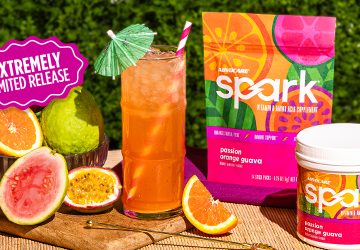
There is a growing interest in improving our ‘gut health’. Good gut health may be considered when we have optimal food digestion and absorption and are free of unwanted gastrointestinal symptoms such as bloating, gas, and irregular stool consistency and bowel movements. Research advancements over recent years has helped us realize that our gut microbiome plays an important role in supporting our gut health and immune system. The gut microbiome, frequently termed our “hidden metabolic organ”, is comprised of trillions of microbes including bacteria, archaea, fungi and viruses that live primarily in our lower digestive tract (colon) and feed off what we eat. Studies repeatedly show that diet composition influences the health of our gut microbiome which prefers to be fed a healthy diet that is rich in fresh fruits, vegetables, and fiber and low in simple sugars and saturated fats. In addition to eating a healthy diet, people may seek other ways to support gut health through supplements.
What are all these “biotics”?
Dietary supplements aimed at supporting gut health include prebiotics, probiotics, synbiotics and postbiotics. In general terms, prebiotics (e.g., inulin, fructo-oligosaccharides) can be considered the “bug food” or fuel source for the gut microbiome, probiotics are the microbes themselves, and synbiotics are a physical combination of pre- and probiotics. Additionally, postbiotics are metabolic byproducts produced or derived from probiotics such as short-chain fatty acids (SCFA), enzymes, hormones, and bacteriocins, an antimicrobial protein. Various postbiotics themselves may be beneficial. For example, production of SCFA or lactic acid creates a more acidic environment in the colon which can then prevent bad bacteria from thriving, as they prefer a less acidic environment. Also, SCFA, especially butyrate, is known to support the immune system and gut barrier to prevent “leaky gut”. Currently identified probiotics consist primarily of bacteria, but also include yeasts. They are naturally present in fermented foods, may be added to other food products, and are available as dietary supplements. If you are confused on what that means or how to determine an optimal probiotic supplement you are not alone. Keep reading to better understand these concepts and understand how different probiotics work to help you choose the best probiotic product for you.
How is a Probiotic Defined?
Healthy gut microbes (commensals) that have been isolated from the human gut and are well-characterized often are the source of probiotics. But until this process of characterization of the microbe has been completed, commensals in general are not to be considered “probiotics”. The International Scientific Association for Probiotics and Prebiotics defines probiotics as “live microorganisms that, when administered in adequate amounts, confer a health benefit on the host.” [1] In order for a microbe to be considered a probiotic, it must meet strict criteria. [1] These include:
- Microbe identification at the Genus and species level, and since probiotics within the same Genus and species can have strain-specific and unique characteristics, they should also be identified at the strain level using an alpha-numeric strain designation. An example of this is: Lactobacillus (Genus) rhamnosus (species) Lr-32 (strain).
- Be able to survive when passing through acid in the stomach and bile salts in the small intestine and reach the colon to enhance the presence of beneficial microbes within the host.

- May promote colonization by adhering to the intestinal lining, producing byproducts that prevent growth of harmful microbes, and have metabolic effects such as producing vitamins or enzymes.
- Must have documented history of safe use.
Thus, adhering to these criteria, “live and active culture” labeling that may appear on a food product does not necessarily indicate the product is probiotic containing, this just means the product contains live cultures at time of its manufacture. [3] For example, many starter cultures used to make fermented foods, such as yogurt, may not meet the above criteria to classify them as a probiotic. However, food products containing “live and active cultures” may have probiotics added to them after the final food product is made and these microbes will be listed on the product label.
What are the Differences Amongst Probiotics?
Most probiotic supplements are comprised of bacteria or yeasts that are lyophilized (dried) preparations of vegetative (active/live) cells (e.g., lactobacilli, bifidobacteria). Probiotics are considered safe and have an established GRAS (Generally Recognized as Safe) status with the Food and Drug Administration (FDA). How a probiotic may exhibit its effects to enhance the gut microbiota varies depending on the Genus/species/strain of the microbe. Highlighted below are known beneficial effects of several probiotics.
Lactobacillus Genus
Lactobacillus spp. contains over 180 species that are native to the gastrointestinal tract and members of the Firmicutes phylum and the family Lactobacillaceae. They are a diverse group of gram positive, non-spore forming bacteria that are commonly isolated from dairy products and humans, and they produce lactic acid from carbohydrates, hence their name. They are one of the most common probiotics found in foods and supplements, with many notable beneficial effects based on the species and strain.
Lactobacillus acidophilus strain La-14 [4]
First isolated from infant feces in 1900, L. acidophilus plays an important role in the gut by producing important metabolites (postbiotics) and regulating gut microbial balance. By producing lactic acid, the gut luminal pH is reduced which inhibits the growth and function of potentially harmful or bad bacteria. L. acidophilus has immune supporting effects (promotes healthy inflammatory responses), and produces digestive enzymes such as lactase, the enzyme that digests lactose in dairy products, which may support digestion and help improve the breakdown of milk sugar (lactose). This may help individuals who have some difficulty digesting dairy products. L. acidophilus La-14 also produces bacteriocins that provide defense against potentially harmful microbes in the gut. [5] In experimental animal studies, L. acidophilus La-14 supported liver health and induced Lactobacillus and Bifidobacteria species. [6]
Lactobacillus plantarum [7]
L. plantarum can be found in various places such as dairy products, vegetables, meats, wine and the gastrointestinal, vaginal and urinary tracts of mammals. It is commonly used to ferment foods such as cheese, meats, and vegetables. Multiple health benefits have been found for L. plantarum including providing a cholesterol-managing effect (existing healthy levels) and aiding in the management of gut issues such as occasional or infrequent diarrhea, undesirable inflammatory responses, and other bowel complaints. L. plantarum is noted to produce many postbiotics including SCFA and bacteriocins, with certain strains producing several bacteriocins which are active against potentially harmful microorganisms in the intestinal tract. L. plantarum’s antimicrobial properties have made it attractive for food safety and potentially decrease the need for chemical preservatives.
Lactobacillus rhamnosus strain Lr-32 [8,9]
L. rhamnosus species exhibits anti-microbial responses against possibly unsafe bacteria. L. rhamnosus Lr-32 has been shown to inhibit certain pathogens in lab-based experiments through multiple mechanisms including secretion of postbiotics. In animal studies with laying hens exposed to antibiotics, L. rhamnosus Lr-32 restored gut microbiome composition, prevented a “leaky” gut and blood-brain barrier, and increased genes related to serotonin, a neurochemical involved in the gut-brain axis; and these effects were linked with improving anxious-like behaviors in the hens.
Lactobacillus lactis strain Ll-23 [10]
Lactobacillus and bifidobacterium are known to possess enzymes to break down proteins, and this technology has been harnessed for centuries in the fermentation of foods. L. lactis Ll-23 was shown to increase the soluble protein content of the plant-based proteins, soy and pea, which can lead to their increased availability to the host for absorption.
Bifidobacterium Genus [11]
Bifidobacterium spp., comprised of 80 (sub)species, are native to the gastrointestinal tract and members of the diverse Actinomycetota (or Actinobacteria) phylum and the family Bifidobacteriaceae. They are gram positive, non-spore forming bacteria noted for their ability to metabolize oligosaccharides. Bifidobacterium are the most common bacteria found in human infants, especially during the first year of life, and are also present in the adult microbiome. Bifidobacterium interact with other gut bacteria and can also inhibit the growth of potentially harmful microbes in the intestinal tract. Some ways they do this include secreting organic acids that reduce the pH in the gut, releasing bacteriocins, or stimulating the immune system. Bifidobacterium are responsive to dietary supplementation of prebiotics which can increase their numbers in the gut microbiome and their production of SCFA.
Bifidobacterium bifidum [12]
Strains from B. bifidum and B. breve are species shared between mother and infant and shown to persist in the human gut for the first year of life. B. bifidum produce protein molecules that exert distinct immune responses that counteract bad microbes in the gut. B. bifidum also supports the growth of other beneficial or friendly Bifidobacterium species.
Bifidobacterium longum [13]
B. longum comprises about 56% of Bifidobacterium abundance in the human infant gut microbiome. B. longum is noted to colonize the gut microbiome readily and lastingly, likely due to its hearty ability to metabolize dietary fibers. As a result of carbohydrate metabolism, B. longum produces SCFA which reduce the pH in the gut or increase intestinal antibody release to prevent overproduction of unfriendly microbes in the intestinal tract. Supplementation with B. longum by itself or in combination with other probiotics has shown benefits in gut health as well as in cardiometabolic, skin, respiratory, and brain health.
Bifidobacterium animalis lactis [14]
B. animalis lactis has been shown to improve gut health. B. animalis lactis may beneficially assist with bowel movement frequency and stool consistency.
Bacillus Genus [15]
Bacillus spp. are gram-positive microbes found widespread in nature which are within the Bacillota phylum and Bacillaceae family. They are highly stable because they are spore-forming and thus able to remain dormant and become active (vegetative) when they encounter their optimal environmental conditions, as within the large intestine. This is an attractive feature of a probiotic as it can be challenging to maintain probiotics in a “live and active” state when in supplement form or as it moves through the gut and reaches the colon. Having a probiotic that remains inactive until it reaches its target is ideal.
Bacillus coagulans [15]
Bacillus coagulans produce postbiotics including lactic acid and a bacteriocin named coagulin. This bacteriocin is antimicrobial against many possibly harmful gut microbes. B. coagulans is blood lipid lowering and supports cardiometabolic health.
Bacillus coagulans (Sanzyme 1969™) [16- 18]
Bacillus coagulans SNZ 1969™ is a proprietary strain that has been used as a probiotic for over 50 years and is consumed worldwide. It is notable for being able to tolerate low pH, bile acids and high heat, does not need refrigeration, and is stable in foods and on the shelf for more than 3 years. It produces lactic acid, helps wards off unfriendly bacteria in the gut and supports immunity. It has shown benefits in supporting gut health (e.g., abdominal discomfort, bowel regularity, digestion, and gut microbial balance), oral health and women’s health (vaginal microflora).
Bacillus subtilis DE111® [19, 20]
Bacillus subtilis is a safe and well-tolerated probiotic with a long history of use in fermented foods. With both adults and children, it has been tested as a probiotic in many studies involving digestive conditions, immunity, antibiotic-associated diarrhea, microbiome composition and overall general wellness. B. subtilis DE111 exerts its effects by secreting a variety of enzymes that assist in digestion of dietary components, releasing antimicrobial compounds to combat unfriendly microbes to help maintain an optimal gut microbiome composition and support a healthy immune system.
Conclusion
As with many nutritional topics, probiotics are not easy to summarize due to continued new insights to their benefits. As each probiotic may have a different effect, understanding the basics of probiotics will assist you in selecting the right product for you. Supporting your gut microbiome is a known strategy for obtaining good gut health. In addition to eating a healthy diet, probiotic supplementation may assist with making your microbiome happy.
Sources:
References
- Hill C, Guarner F, Reid G, Bibson GR, Merenstein DJ, Post B, et al. The international Scientific Association for Probiotics and Prebiotics consensus statement on the scope and appropriate use of the erm probiotic. Nat Rev Gastroenterol Hepatol 2014;11:506-14.
- World Gastroenterology Organisation Global Guidelines, 2017. https://www.worldgastroenterology.org/UserFiles/file/guidelines/probiotics-and-prebiotics-english-2017.pdf Accessed on 2/3/2024
- IDFA International Dairy Foods Association https://www.idfa.org/live-active-cultures-seal#:~:text=The%20words%20%22live%20and%20active,milk%20to%20yogurt%20during%20fermentation accessed on 2/3/2024
- Gao H, Chen H, Hai D, Wei C, Zhang L, Li P. The functional roles of Lactobacillus acidophilus in different physiological and pathological processes. J Microbiol Biotechnol 2022;32:1226-1233.
- Todorov SD, Furtado DN, Saad SMI, de Melo Franco BDG. Bacteriocin production and resistance to drugs are advantageous features for Lactobacillus acidophilus La-14, a potential probiotic strain. New Microbiologica 2011; 34:357-370.
- Lv L, Yao C, Yan R, Jing H, et al. Lactobacillus acidophilus LA14 alleviates liver injury. MSystems 2021; 6: e00384-21
- Seddik HA, Bendali F, Gancel F, Fliss I, Spano G, Drider D. Lactobacillus plantarum and its probiotic and food potentialities. Probiotics & Antimicro Prot 2017;9:111-122.
- Huang C, Yue Q, Sun L, Di K, et al. Restorative effects of Lactobacillus rhamnosus LR-32 on the gut microbiota, barrier integrity, and 5-HT metabolism in reducing feather-pecking behavior in laying hens with antibiotic-induced dysbiosis. Front Microbiol 14:1173804. Doi:10:3389/fmicb.2023/1173804
- Vale GC, Mayer MPA. Effect of probiotic Lactobacillus rhamnosus by-products on gingival epithelial cells challenged with Porphyromonas gingivalis. Arch Oral Biology 2021;128:105174.
- Marttinen M, Anjum M, Saarinen M, Ahonen I, et al. Enhancing bioaccessibility of plant protein using probiotics: an in vitro study. Nutrients 2023; 15:3905. Doi.org/10.3390/nu15183905
- Hidalgo-Cantabrana C, Delgado S, Ruiz L, Ruas-Madiedo P, et al. Bifidobacteria and their health promoting effects. Microbiology Spectrum 2017; 5:BAD-0010-2016 doi:10.1128/microbiolspec.BAD-0010-2016
- Turroni F, Duranti S, Milani C, Lugli G, et al. Bifidobacterium bifidum: A key member of the early human gut microbiota. Microorganisms 2019; 7:544. Doi: 10.3390/microorganisms/7110544
- Mills S, Yang B, Smith GJ, Stanton C, Ross RP. Efficacy of Bifidobacterium longum alone or in multi-strain probiotic formulations during early life and beyond. Gut Microbes 2023; 15: 2186098 doi.org/10.1080/19490976.2023.2186098
- Araujo MM, de Oliveira Vogado C, Mendes MM, et al. Effects of Bifidobacterium animalis subspecies lactis supplementation on gastrointestinal symptoms: systematic review with meta-analysis. 2021; Nutr Rev 80:1619-1633.
- Lee NK, Kim WS, Paik HD. Bacillus strains as human probiotics: characterization, safety, microbiome, and probiotic carrier. Food Sci Biotechnol 2019; 28:1297-1305.
- Soman RJ, Gorantla SC, Swamy MV. Evaluation of efficacy and safety of Bacillus coagulans SNZ 1969 supplementation for irritable bowel syndrome: a randomized double-blind, placebo-controlled study. Intl J Basic Clin Pharm 2022; doi.org/10.18203/2319-2003.ijbcp20222353
- Soman RJ, Singh K, Swamy MV. Efficacy and safety of probiotic Bacillus coagulans-SNZ 1969 in gastrointestinal discomfort: a randomized, placebo-controlled study. Int J Health Sci & Res 2022; 12:3 doi.org/10.52403/ijhsr.20220336
- Rani VU, Rao SR, Grisha P, Sharma AV, Usha MS. The efficacy of probiotic B. coagulans SNZ-1969 tablets in the treatment of recurrent bacterial vaginosis. Intl J Probiotics Prebiotics 2017; 12:175-182.
- Freedman KE, Hill JL, Wei Y, et al. Examining the gastrointestinal and immunomodulatory effects of the novel probiotic Bacillus subtilis DE111. Int J Mol Sci 2021;22:2453. Doi.org/10.3390/ijms22052453.
- Mazhar S, Khokhlova E, Colom J, Simon A, et al. In vitro and in silico assessment of probiotic and functional properties of Bacillus subtilis DE111®.

Gail A. Cresci
Staff, Pediatric Institute & Lerner Research Institute Departments of Gastroenterology & Pathobiology Cleveland Clinic and member of AdvoCare Scientific and Medical Advisory Board.
Organizations
- Academy of Nutrition and Dietetics
- Dietitians in Nutrition Support
- American Society of Parenteral Enteral Nutrition
- Society of Critical Care Medicine
- American Gastroenterology Association
Honors
- Excellence in Practice: Clinical Nutrition Award, Academy of Nutrition and Dietetics
- Distinguished Nutrition Support Dietitian Advanced Clinical Practice Award, American Society of Parenteral Enteral Nutrition
- Promising New Investigator, American Society of Parenteral and Enteral Nutrition
- Excellence in Practice: Dietetics Research Award, Academy of Nutrition and Dietetics
Published Works
More than 75 scientific and educational publications in nutrition and digestive diseases.
Education
- Bachelor of Science, University of Akron
- M.S., Rosalind Franklin Health Sciences University
- Ph.D., Georgia Regents University (formerly Medical College of Georgia)




